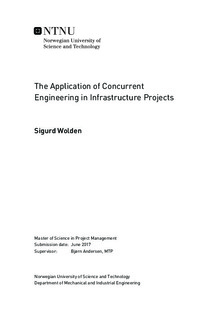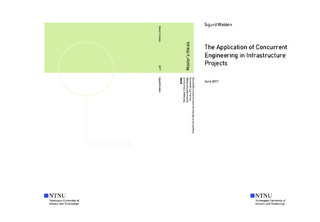| dc.description.abstract | The construction industry today is considered to be lagging competitively behind in comparison to other industries. The reason for this is thought of by many researchers to be the fragmented project process, the traditional principles and the, sometimes adversarial environment. In order to solve some of these obstacles and at the same time enhance productivity, the Norwegian infrastructure sector has recently developed an interest towards the project management method Concurrent Engineering (CE). Coupled with this and the general lack of research on CE in infrastructure projects presented a research opportunity. In fact, the Concurrent engineering method has almost exclusively been regarded as an approach that has great potential in improving project development time, increase quality and decrease cost. However, the adaptation of the method towards the construction industry, which originally was a manufacturing/production project method, has been paved with challenges, further advocating a research opportunity.
Therefore, the purpose of this thesis was to contribute to the general research field of concurrent engineering, and present findings that can substantiate the understanding of, and the utilization of, the CE method in the infrastructure sector. The overarching method involved exploring the utilization of concurrent engineering within infrastructure projects in comparison to traditional project methods. The problem statements constitutes identifying effects and obstacles to the use of the method in project work sessions, called CE sessions.
In order to identify significant findings of the utilization of the concurrent engineering method, a qualitative approach was chosen, which involved the research method of interviewing a sample of 14 project managers and the observation of a CE session in the infrastructure sector.
The generalizable results of the thesis were that an increase in collaboration and communication occurred between the project team members. In addition, through the involvement of the whole project life cycle s stakeholders, the project team members understand more in-depth the elements of the project and ultimately, the team members become more quality- and problem-aware during the work sessions. The CE method however, also increased the complexity of coordinating and developing the plan. Moreover, potential obstacles to the effects identified were level of integration, particularly involving external stakeholders, low level of autonomy and insufficient preparation and practice. In addition to these identified effects and obstacles, by involving the external decision-makers on the plan early and during the plan development could potentially expedite the time to plan approval as well as increase the quality of plan. | |

